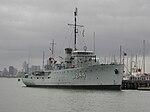Williamstown railway station
Heritage-listed buildings in MelbourneListed railway stations in AustraliaPremium Melbourne railway stationsRailway stations in Australia opened in 1859Railway stations in the City of Hobsons Bay ... and 2 more
Use Australian English from February 2015Williamstown, Victoria

Williamstown railway station is the terminus of the electrified suburban Williamstown line in Victoria, Australia. It serves the western Melbourne suburb of Williamstown, and it opened on 17 January 1859.The station building is listed on the Victorian Heritage Register, and is the second oldest railway station in Victoria, after St Kilda. It is also the oldest timber railway station building to survive in the state, and one of the earliest surviving timber public buildings in Victoria.At the up end of the station platform, the double track railway converges into single track.
Excerpt from the Wikipedia article Williamstown railway station (License: CC BY-SA 3.0, Authors, Images).Williamstown railway station
Railway Terrace, Melbourne Williamstown
Geographical coordinates (GPS) Address External links Nearby Places Show on map
Geographical coordinates (GPS)
| Latitude | Longitude |
|---|---|
| N -37.8677 ° | E 144.9054 ° |
Address
Williamstown
Railway Terrace
3016 Melbourne, Williamstown
Victoria, Australia
Open on Google Maps







